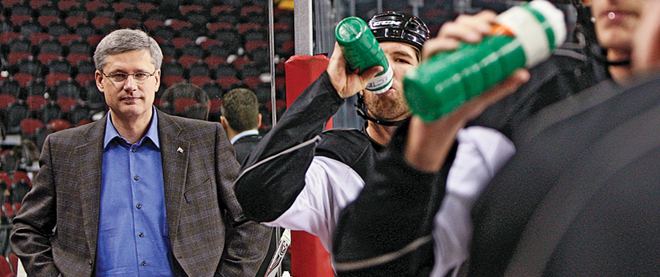How the Prime Minister could rescue hockey
Heads of state have interfered in pro sports before
Michael Tran/FilmMagic/Getty Images
Share

It may be the most thrilling of winter sports, but summer is proving to be hockey’s toughest season.
In June, Vancouver was terrorized by a massive riot following the seventh game of the Stanley Cup finals. In recent months three well-known NHL tough guys were found dead by their own hand: Rick Rypien and Wade Belak from apparent suicide, Derek Boogaard from accidental drug overdose.
And head trauma continues to cast a pall over the entire sport. While professional hockey has always involved substantial physical contact and ritualized fighting, new research suggests hockey tough guys such as Boogaard, Rypien and Belak may face a lifetime of degenerative brain disease and depression. Shots to the head are shortening the careers of many talented players as well. Gifted left winger Paul Kariya retired in June due to post-concussion syndrome. In August, the Boston Bruins’ star centre Marc Savard (who signed a $28-million, seven-year contract in 2009) announced he won’t play this coming season because of a concussion. He may never play again.
Most depressing, Sidney Crosby of the Pittsburgh Penguins missed half of last season—cutting short a year that was shaping up to be one of hockey’s greatest—with back-to-back concussions and, as Maclean’s went to press, he was scheduled to give a press conference outlining his plans for this fall.
The enduring popularity of hockey is clearly at risk when its biggest star and most marketable personality can’t play. If the public image of hockey calcifies around the observation that it is a dangerous sport characterized by frequent head injuries, parents will quite rationally enroll their sons or daughters in less hazardous pursuits. Casual fans will turn away. Sponsors will look elsewhere for advertising opportunities. The storied place of hockey in Canadian culture could be imperilled. The risk here is extremely serious. Can hockey turn itself around?
The responsible parties have all dutifully responded to hockey’s summer of discontent. Following the deaths of Belak et al., the NHL and players’ association promised “a thorough evaluation of our existing assistance programs and practices . . . to enhance player welfare.” The city of Vancouver conducted an independent review of the riot. The NHL regularly investigates controversial hits and hands out suspensions. Referees now pay more attention to blind-side hits and additional rule changes seem likely.
And yet it will take more than rule tweaks and player assistance programs to shift public perception in a meaningful and permanent way. Major changes to the very nature and culture of the sport will be required to really fix things. Prime Minister Stephen Harper may even need to get involved. There is precedent.
In the early 1900s, American football was under a threat similar to that faced by hockey today. The brutal nature of the game (in 1905, 18 players died on U.S. gridirons) led to widespread public revulsion. Many universities, including Harvard, Columbia, Stanford and Northwestern, quit playing. The Georgia legislature voted to ban the sport.
President Theodore Roosevelt, however, was a big fan of football and the rugged virtues it promoted. In response to the threats to the sport’s continued existence, he quietly convened a White House football conference, bringing together the era’s most important coaches, a meeting recounted in John J. Miller’s recent book The Big Scrum: How Teddy Roosevelt Saved Football.
“Football is on trial,” Roosevelt told the coaches. “Because I believe in the game, I want to do all I can to save it.” While Roosevelt took no effort to dictate what changes ought to be made, with his encouragement the sport completely reinvented itself. The forward pass became legal. First downs required 10 yards, rather than five, which helped open up the game. Plays that put players’ heads and necks at risk were explicitly prohibited. A game characterized by massive pileups, broken necks and eye gouging went on to become the most popular spectator sport in the U.S. today.
Politicians obviously have no business micromanaging sport, but our Prime Minister could use his stature to encourage hockey to abandon its violent status quo in favour of something new and better, as Roosevelt did. Everything should be up for grabs. A bigger ice surface would place greater emphasis on skating and compensate for the obvious inflation in player size over the decades. Fighting could be banned outright and the position of team goon made redundant. Team benches could be shortened to eliminate the fourth line. Teams could play four aside the entire game. All contact to the head could be illegal.
Hockey should properly be known as an exciting, fast-paced game played with skill and grace, not the former occupation of athletes suffering from post-concussion syndrome, brain disease and depression. It’s time to reinvent the sport.